Caring for Anthurium Plants as Houseplants
The genus Anthurium is the most numerous genus of the Araceae family. The Latin name of the genus comes from the ancient Greek words "flower" and "tail."
The genus comprises, according to various estimates, from 500 to 900 species of diverse plants—herbaceous evergreen plants, lianas, and mainly epiphytes growing on trees in tropical forests, with aerial roots descending to the forest floor. Some Anthurium species are lithophytes adapted to life on rocky surfaces. The native habitat of Anthurium, also known as the flamingo flower, is Central and South America.
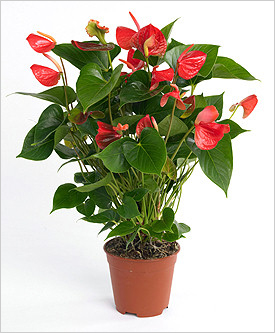
Anthurium leaves come in various shapes: heart, spatula, round, and some species have dissected leaves. The leaf surface can be matte or glossy. In the conditions of a humid tropical forest, Anthurium leaves have a unique ability to turn towards the sun. Anthurium leaves are poisonous.
They contain calcium oxalate crystals that cause severe burning in the mouth. Keep the plant away from pets who may play with or chew on its foliage.
However, the main advantage of this plant is the "flowers" of various shades, ranging from dense glossy deep red to snow-white, as well as lilac, burgundy, and even green. In indoor cultivation, varieties with multicolored and even black spathes have been developed. The brightly colored covering envelops the inflorescence, which can be club-shaped, cone-shaped, spiral-shaped, or spherical and of different colors. The flowers themselves are densely arranged on the spadix and resemble diamonds and squares.
The flowers of different species have different scents, ranging from barely noticeable to very strong, pleasant or unpleasant.
Anthurium can bloom year-round (with sufficient light), and the flowers can last on the plant for a long time, up to one and a half months. After pollination, mature fruits - berries of yellow or orange color with two seeds - can be obtained.
Over time, Anthuriums age, lose their decorative appeal, the leaves become smaller, and the plant develops a dry stem with remnants of leaf petioles. In this case, it is useful to "rejuvenate" Anthurium.
Anthuriums look very striking and original, so florists often use them to decorate the interiors of apartments and offices.
The "flowers" of Anthuriums are excellent for cutting and can last in water for 3-4 weeks or more, making them indispensable for creating flower arrangements along with their decorative properties.
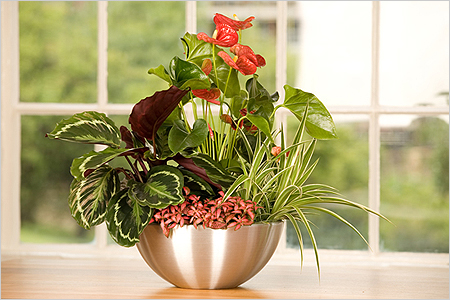
As indoor plants, Anthurium andreanum and Anthurium scherzerianum are most often grown.
Anthurium andreanum is a large plant with large heart-shaped dark green leaves on long petioles. Numerous aerial roots form on the stems. The covering is leathery, heart-shaped, often blistered with well-visible veins, and the color of the covering can be white, pink, yellow, red, or green.
Anthurium scherzerianum is an epiphyte with shortened stems, up to 40 cm tall. The leaves are leathery, dark green, matte, covered with small black dots on both sides. The inflorescences usually rise above the plant. The covering is dense, bright red (there are varieties in other colors).
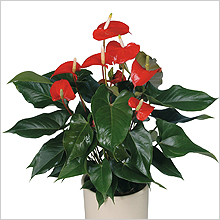

There are also species among Anthuriums that are grown as decorative foliage plants. In indoor cultivation, Anthurium Crystallinum is known, a plant with very beautiful leaves. The color of the leaves changes from bronze-purple to dark green with age. The leaves are up to 20 cm long, heart-shaped, with a velvety surface, on which bright silver veins are clearly visible. The covering of the flower of Anthurium Crystallinum is green or slightly purple.
Among the foliage decorative Anthuriums, there is also Anthurium magnificum, similar to Anthurium Crystallinum. In indoor conditions, it is a low-growing plant with beautiful large dark green velvety leaves with white veins. There are many transitional forms between these two varieties.
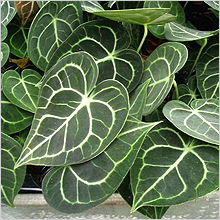
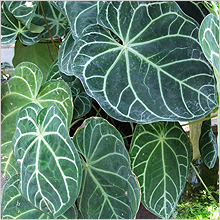
Caring for Anthurium Plants as Houseplants
Anthurium is a rather finicky flower, challenging to cultivate in home conditions, and many Anthurium species are intended only for heated greenhouses. It is much easier to care for hybrid Anthuriums, derived from Anthurium Andre, as they are more commonly found in the market.
These are undemanding plants, resistant to pests and diseases. They have compact sizes and can be propagated without much trouble by dividing the mature bush.
Be cautious when handling Anthurium: it contains substances that can irritate mucous membranes.
Light: Bright diffused light is suitable, and southern, eastern, and western windows work well. These plants are quite shade-tolerant and can grow on a north-facing window, but they won't flower. In winter, additional lighting is needed for the emergence of new buds. They can bloom in winter on southern windows. During hot summers, especially in the south, it's advisable to move the plant away from direct sunlight, and a suitable place could be a table near the window.
Temperature: Anthurium is a tropical plant, and the optimal temperature between 65 and 85 degrees Fahrenheit (20-25°C); in winter, it can be kept at a temperature of 16-18°C. Drafts and sudden temperature fluctuations are detrimental to Anthurium. These plants can be grown outside in zones 11 to 12 and will likely perish at temperatures of 40 degrees Fahrenheit or less.
Water: Water regularly with lukewarm water, every 3-4 days in warm weather, and once a week in winter. Anthuriums are very sensitive to proper watering. They do not tolerate either drying out of the soil or water stagnation in the pot. Excess water should be drained from the tray some time after watering. Do not water Anthuriums with hard or cold water. Anthuriums require an acidic substrate, so if the water is hard, their leaves turn yellow.
Air Humidity: Anthurium is native to humid tropical forests and prefers high air humidity. It is desirable to regularly spray the leaves, but avoid spraying the inflorescences—they can get spots and fall off faster. It is recommended to place damp sphagnum moss on top of the pot, closer to the stems of the plants. This provides moisture to the aerial roots and stimulates their growth. How to increase air humidity.
Fertilizer: During the growth and flowering period, fertilize twice a month with a mineral solution or organic fertilizer.
Repoting: Young plants are transplanted every year in spring, and adults are replanted every two years . The container should be shallow and wide, with good drainage.
Soil: The soil mixture consists of compost, coarse (unscreened) leaf soil, peat, and sand (2:1:1:0.5). In addition, the substrate should include pieces of broken brick, cones, moss, and wood charcoal. The coarse fraction should make up 10-15% of the total volume of the mixture to improve air and water permeability. The reaction of the soil mixture should be slightly acidic (pH 5.5-6.5).
Propagation: Anthurium can be propagated by dividing overgrown plants, seeds, apical and stem cuttings, and lateral shoots with independent roots.
Anthuriums have a way of telling you that they're ready to propagate; they send out "air roots." Anthurium roots are fleshy, appearing almost knobby or tuberous. They'll start jutting out from a stem above the soil line in the pot. This can happen during any season.
The easiest way to propagate is by stem cuttings stem in spring. Alternatively, you can cut the top part of the stem with roots, and divide the bottom into small segments (5-10 cm) and plant them in a greenhouse, a box under glass.
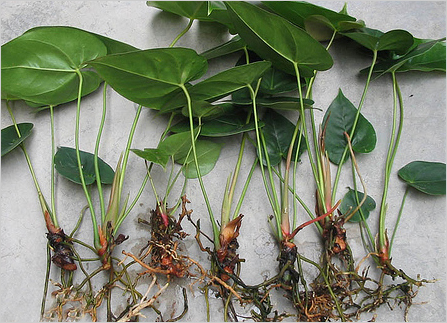
Seeds can only be obtained through artificial pollination. Bright fruits – berries, each containing 1-4 seeds, form 8-12 months after pollination. Rinse the seeds with water and soak them for 2 hours in a weak (0.1%) potassium permanganate solution to prevent mold on the seeds.
Sow immediately after ripening at a temperature of 25°C; they will sprout in a few months. The first flowering of an Anthurium grown from seeds occurs after 4 years.
Pests: Anthurium is susceptible to scale insects, thrips, mealybugs, and aphids. It can also be damaged by various parasitic fungi, which manifest as spots on the leaves. Anthracnose is dangerous; with this disease, the leaves start to dry at the edges, and if severely affected, the plant dies.




